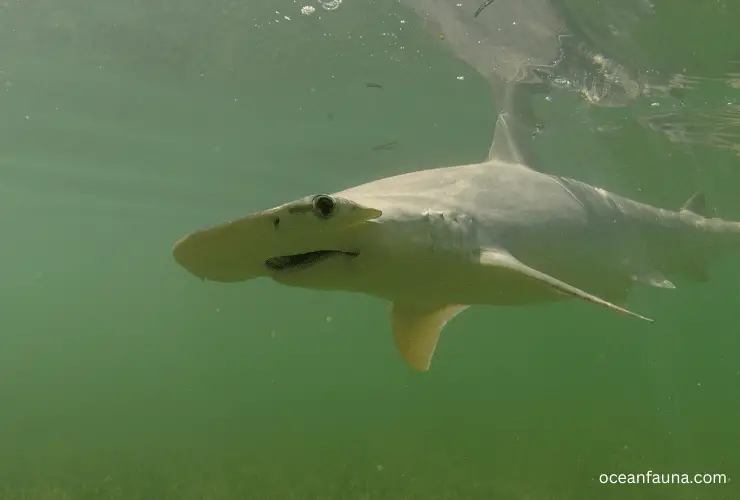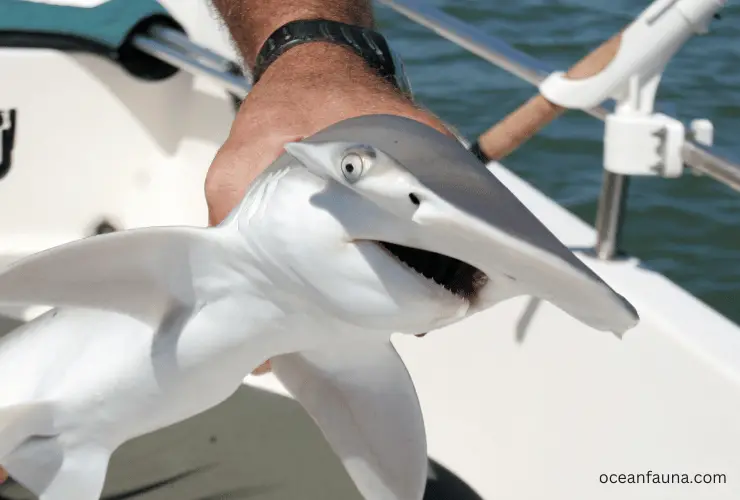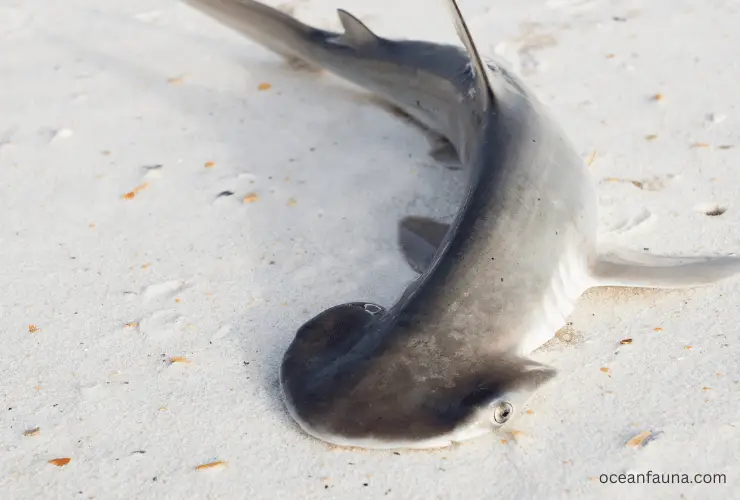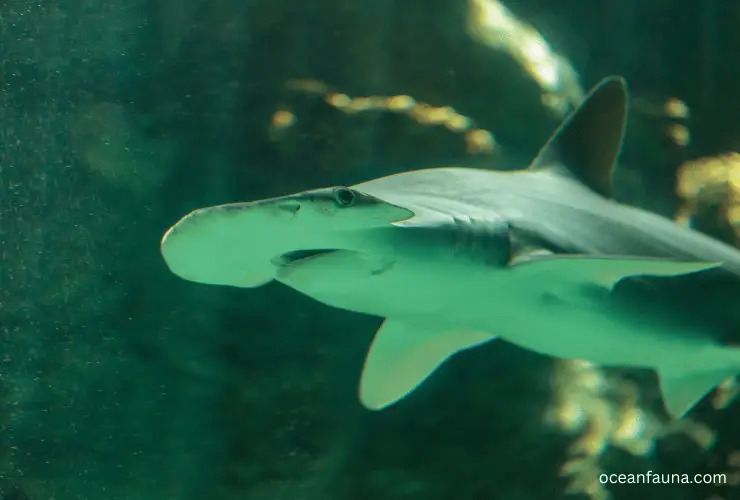The bonnethead shark, also known as the shovelhead shark or Sphyrna tiburo, is a species of hammerhead shark that prefers Tropical Reef Habitats. Divers may find them living in shallow areas of tropical and subtropical oceans around the world.
It is one of the smallest species of hammerheads and gets the name due to having a distinctively shaped head with a rounded “bonnet” or shovel-like shape.
Are you curious about the Bonnethead Shark? Worry not—this article will answer all of your inquiries, from anatomy and diet to habitat, reproduction, predators, conservation efforts, and more. So strap in for a fascinating journey into this majestic creature’s life. Let’s explore.
Bonnethead Shark at a Glance
| Category | Information |
| Common Names | Bonnethead Shark, Shovelhead, Bonnet Shark |
| Scientific Name | Sphyrna tiburo |
| Order | Carcharhiniformes |
| Family | Sphyrnidae |
| Diet | Crabs, shrimp, bony fish, octopus, marine plants |
| Habitat | Shallow coastal waters, bays, estuaries, mangroves |
| Distribution | Western Atlantic Ocean to Eastern Pacific |
| Size | 3 to 4 feet |
| Weight | Up to 24 lbs |
| Life Expectancy | Average 12 years |
| Reproduction | Viviparous (gives birth to live young) |
| Gestation Period | 4 to 5 months |
| Litter Size | 8-12 pups |
| Conservation Status | Endangered |
You already know the Bonnethead Shark, also known as the shovelhead shark or bonnet shark. It is one of the most common sharks found in estuaries and shallow coastal waters of the Western Atlantic and eastern Pacific.
The Bonnethead Shark is named after its unique head shape, which is flattened and shaped like a shovel. The head is wider than it is long and has a rounded snout that is not as pointed as other hammerhead sharks. The shark’s body is brownish-grey in color, and it can grow up to 3-4 feet in length and weigh up to 24 pounds.
Amazing Facts about the Bonnethead Shark
- The Bonnethead Shark gets the name for its bonnet-shaped head.
- The shark’s unique head shape gives it an increased field of vision.
- Bonnethead Sharks can digest seagrass and other aquatic vegetation due to their unique digestive system.
- The species is found in shallow coastal waters, including mangrove swamps and estuaries.
- They are often used for scientific research due to their hardiness and adaptability.
- These sharks are social creatures and are mostly found in groups.
- The Bonnethead Shark is not dangerous to humans.
- The sharks have a lifespan of around 10-12 years.
- The species is currently classified as “Endangered” by the IUCN Red List.
- The sharks are frequently caught as bycatch in commercial fishing nets.
Anatomy of the Bonnethead Shark (Detailed Analysis)
The bonnethead shark has a unique head shape that serves as an excellent adaptation to catch prey, with their wide-set eyes and nostrils allowing them to hunt in a wide range of conditions. Let’s take a closer look at the anatomical systems of the bonnethead shark:

Skeletal System
Like all other sharks, the bonnethead shark’s skeletal system is composed of cartilage rather than bone. Cartilage is a flexible, lightweight substance that helps the shark easily move through the water.
They have a skull that is flattened and wide, resembling a shovel or hammer. The hammer-shaped head provides an advantage for detecting and trapping prey. The shark’s spine is also composed of cartilage, which helps to protect the spinal cord from damage.
Muscular System
Bonnethead sharks have a muscular system that is designed for swimming and hunting. They are able to swim for long periods without getting tired due to their powerful, streamlined body.
The shark’s fins are also essential for swimming and balancing in the water. The pectoral fins are used for steering and braking, while the dorsal fin helps to stabilize the shark in the water.
Respiratory System
Like all fish, the bonnethead shark has a specialized respiratory system that allows it to breathe underwater. They extract oxygen from the water using their gills, which are located on the sides of their head. The shark can take in water through its mouth and pump it over the gills in order to extract oxygen from the water.
Digestive System
The bonnethead shark’s digestive system is designed to process various food items. They are omnivores, meaning that they eat both plants and animals.
The shark’s teeth are serrated and pointed, providing an effective tool for ripping and tearing prey. Their stomach is divided into two compartments, allowing them to digest food more efficiently.
Circulatory System
The bonnethead shark’s circulatory system is closed, meaning the blood is always inside the blood vessels. The shark’s heart is a two-chambered structure that pumps blood through the gills and out to the rest of the body.
Their blood can also transport oxygen more efficiently due to the presence of a specialized protein called hemoglobin.
What Do Bonnethead Sharks Eat?
Bonnethead sharks have a diverse diet, which includes crabs, shrimps, bivalves, snails, and small bony fishes. In addition, they are the only known sharks that eat seagrasses as a regular part of their diet. They are primarily benthic feeders, meaning they feed on prey that is on the ocean floor.
When hunting, bonnethead sharks use their unique head shape to their advantage. Their head is almost circular, allowing them to have a wide field of vision and to detect prey well. They also possess electroreceptors, which allow them to detect the electrical fields of their prey, even when buried in the sediment.
Once they have located their prey, bonnetheads use their sharp teeth to crush and grind the shells of crustaceans and mollusks. They often shake their head from side to side while eating to dislodge the meat from the shells. Although they have a specialized diet, bonnetheads are still opportunistic feeders and will eat other types of prey if the opportunity arises.
Where Do Bonnethead Sharks Live?
Bonnethead sharks are common in the estuaries and shallow coastal waters of the Western Atlantic and eastern Pacific oceans. They prefer to live in water temperatures between 68 and 82 degrees Fahrenheit, making them adaptable to various environments.

These sharks typically live at depths of 10 to 25 meters (33 to 82 feet). However, they have been observed at depths of up to 80 meters (260 feet).
The habitat of the Bonnethead shark is highly diverse, and they can be found in a variety of environments. They are often found in seagrass beds, coral reefs, and salt marshes, as well as in bays and lagoons. These sharks also inhabit intertidal zones, where tidal fluctuations create diverse habitats.
The distribution of the Bonnethead shark is extensive, as they can be found in several different regions around the world. In the Western Atlantic, they are commonly found from New England in the north all the way to Brazil in the south. They can also be found along the eastern Pacific coastline from California down to Peru.
Reproduction and Life Cycle of the Bonnethead Shark
The bonnethead shark is a viviparous species that reproduce sexually. After reaching maturity at around 2 years of age and about 3 feet in length, these sharks mate during the fall season.
Females have a short gestation period of about 4 to 5 months before giving birth to live young in shallow waters. Each litter typically consists of 8 to 12 pups, with an average size of about 12 inches at birth.
Bonnethead sharks have an estimated lifespan of 12 years or more. They reach sexual maturity at a relatively young age and are able to produce offspring annually.
These sharks have a distinctive reproduction process, which sets them apart from other shark species. The viviparous method enables bonnetheads to protect their young until birth, giving them a better chance of survival.
Predators and Threats to the Bonnethead Shark
Bonnethead Sharks face a variety of predators and threats in the wild. More giant sharks, such as the bull and tiger sharks, are known to prey on Bonnetheads. Killer whales have also been known to hunt these small sharks.
However, these natural predators do not pose as significant a risk to the species as human activity does.
Bonnethead Sharks are often caught as bycatch in commercial fishing nets. This is particularly problematic because these animals have a low reproductive rate, which makes it difficult for their populations to recover from overfishing.

Moreover, because Bonnetheads are often harvested for their fins, they are a common target of illegal fishing operations. The fishing industry alone has caused significant declines in Bonnethead populations and continues to pose a threat.
Coastal development also poses a major threat to Bonnethead Sharks. Habitat loss and destruction are common as natural habitats such as seagrass beds and mangrove forests are drained or filled in for development projects. This can significantly impact the small sharks’ ecosystem, leading to decreased food availability and declining populations.
While the Bonnethead Shark population is currently stable, conservation efforts are necessary to ensure their continued survival. Some of these efforts could be things like using fishing gear that is more selective or setting up protected areas for sharks.
It could also involve making people more aware of the need to protect Bonnethead habitats, promoting sustainable fishing practices, and making sure that illegal fishing and coastal development are stopped by the rules that are already in place.
Overall, concerted and sustained efforts are required to protect these vulnerable animals and their habitats.
What Is the Conservation Status of Bonnethead Sharks?
The bonnethead shark has been categorized as Endangered by The IUCN Red List of Threatened Species due to human-induced threats.
Efforts to conserve bonnethead sharks involve a combination of international and domestic regulations and various conservation initiatives aimed at reducing the demand for shark fin products and promoting sustainable fishing practices.
Some places use fish traps, circle hooks, and other sustainable fishing methods to reduce the number of bonnethead sharks caught by accident. Protected areas and marine reserves have also been implemented to provide safe habitats for this endangered species.
Conclusion
The Bonnethead Shark is a unique and fascinating species that is vital to marine ecosystems worldwide. Its distinctive head shape, diet, and adaptability make it a species worthy of our attention and protection.
Conservation efforts are essential to ensure the species stays alive, and research should focus on learning about its biology and how it acts. By working together, we can protect this remarkable species and ensure that it continues to thrive for future generations.

